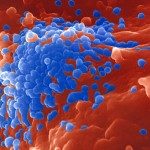Lien vers Pubmed [PMID] – 21900716
Antivir. Ther. (Lond.) 2011;16(6):843-52
BACKGROUND: The female genital tract constitutes a reservoir for HIV providing active production of both cell-free HIV RNA and cell-associated DNA within the cervicovaginal secretions. The objective of this study was to prospectively assess residual HIV-1 RNA and HIV-1 DNA production in the genital tract reservoir of women initiating HAART over an 18-month period.
METHODS: Paired blood and cervicovaginal lavage samples were collected at inclusion and 1, 6, 12 and 18 months after HAART initiation, in 23 women in first-line HAART and six women in virological failure, for measurement of HIV-1 RNA and HIV-1 DNA shedding and/or drug concentrations.
RESULTS: A dramatic decrease of HIV-1 RNA and HIV-1 DNA occurred in both blood and cervicovaginal samples over the first 6 months on HAART, followed by a shelf up to 18 months, independently of the drugs’ genital pharmacokinetics. While cervicovaginal HIV-1 RNA became undetectable in >90% of women from 6 months on HAART, genital HIV-1 DNA remained frequently detectable (27-50%). Nearly 40% of women with sustained undetectable plasma HIV-1 RNA after 6-18 months on HAART harboured transient HIV-1 RNA (15% of women) or HIV-1 DNA (31% of women) in their genital secretions.
CONCLUSIONS: Low-level cervicovaginal HIV-1 shedding is frequently evidenced in HAART-treated women with transient HIV-1 RNA and persistent HIV-1 DNA despite a systemic control of viral replication, resulting in possible residual genital infectivity.

